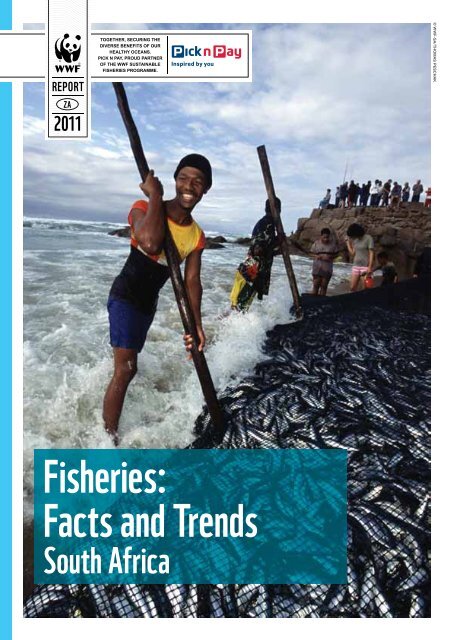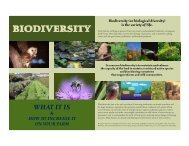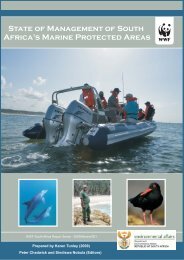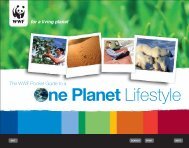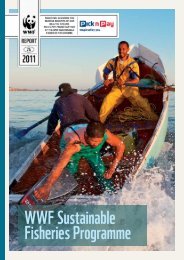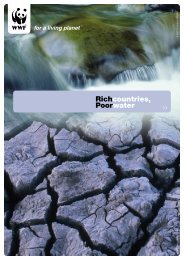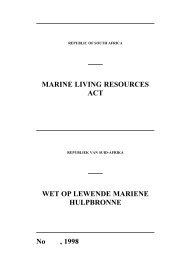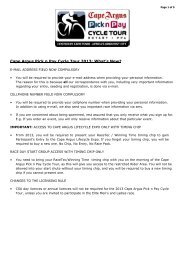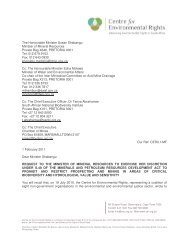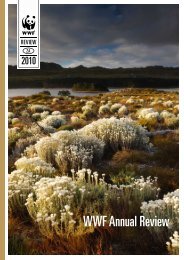Fisheries: Facts and Trends - WWF South Africa
Fisheries: Facts and Trends - WWF South Africa
Fisheries: Facts and Trends - WWF South Africa
Create successful ePaper yourself
Turn your PDF publications into a flip-book with our unique Google optimized e-Paper software.
Forewordby Morné du PlessisChief Executive:<strong>WWF</strong> <strong>South</strong> <strong>Africa</strong>This snapshot report provides an overview of the status of <strong>South</strong> <strong>Africa</strong>’s fishingindustry <strong>and</strong> the marine environment within which it operates. It highlights some ofthe significant challenges facing our marine ecosystems <strong>and</strong> the associated socioeconomic<strong>and</strong> cultural systems which rely on these resources for their wellbeing.The report provides a clear picture of the precarious state in which we find ourselvesafter decades of mismanaging our marine systems. It underscores <strong>WWF</strong>’s drive topromote an Ecosystem Approach to <strong>Fisheries</strong> (EAF), recognising the critical rolethat marine ecosystems play in maintaining resilient socio-cultural systems in theface of growing threats of climate change <strong>and</strong> food security.We have not attempted to provide a comprehensive assessment of every issue, buthave rather tried to provide a broad view which highlights the areas of concern <strong>and</strong>showcases some of the best-practice solutions that we will need to implement inorder to meet humanity’s growing dem<strong>and</strong>s on our marine ecosystem. This is clearlyone of the key challenges of the 21st century.The information in this report has been collated from diverse <strong>and</strong> reliable sources<strong>and</strong> is intended to catalyse collaboration <strong>and</strong> act as a marker against which we canmeasure our progress in years to come.Morné du PlessisChief Executive: <strong>WWF</strong> <strong>South</strong> <strong>Africa</strong>
ConTenTSThe context 3Global trends 5Marine ecosystems of <strong>South</strong> <strong>Africa</strong> 7<strong>South</strong> <strong>Africa</strong>’s sectors 9The status of inshore resources 10The status of offshore resources 13Biodiversity <strong>and</strong> ecosystems 18Bycatch 22The economics of fisheries 24Seafood markets 26Social considerations 30Conclusion 34
© <strong>WWF</strong>-SA/ThomAS PeSchAk
THe ConTeXT“All our natural livingmarine resources <strong>and</strong>our marine environmentbelong to all the people of <strong>South</strong> <strong>Africa</strong>.”Marine Living Resources Act, 1998“HoliSTiCenvironMenTAlMAnAGeMenTSTrATeGieS AndMore SuSTAinABleFiSHinG prACTiCeSAre BeinGeMployed ToenSure preSenTAnd FuTureGenerATionS AreABle To MeeT THeirneedS.”<strong>South</strong> <strong>Africa</strong> is a nation largely defined by the characteristics of its oceans. Theconfluence of two great currents, the cold Benguela Current on the west coast <strong>and</strong>the warm Agulhas Current on the east coast, contributes to the high levels of marinebiodiversity <strong>and</strong> species endemicity found within the region. Boasting a coastlinethat stretches over 3000km from the cool temperate waters of the southeast AtlanticOcean to the subtropical Indian Ocean bordering Mozambique, <strong>South</strong> <strong>Africa</strong>’soceans support diverse artisanal <strong>and</strong> commercial fisheries. The upwelling of cold,nutrient-rich waters along the west coast contributes to the productivity of thisarea, supporting vast commercial fisheries for many valuable fish <strong>and</strong> invertebratespecies, while the warmer, less productive waters of the east coast support severalsmaller fisheries. The long-term sustainability of marine resources throughresponsible <strong>and</strong> collaborative management no doubt plays an essential role in thesocial <strong>and</strong> economic wellbeing of <strong>South</strong> <strong>Africa</strong>’s coastal people. In the past, fisherieshave been managed on the basis of a so-called single species approach to fisheriesmanagement, which only considered the species being harvested in the managementwith no consideration for any other effect the fishing activity had. This strategyhas failed us. Holistic environmental management strategies <strong>and</strong> more sustainablefishing practices are being employed to ensure present <strong>and</strong> future generations areable to meet their needs.In contrast to the previous single species approach to fisheries management, theholistic approach - an Ecosystem Approach to <strong>Fisheries</strong> (EAF) - was adopted.An EAF takes into consideration that all marine organisms <strong>and</strong> processes areinterconnected <strong>and</strong> that alterations in these processes are not easily recognised<strong>and</strong> difficult to restore once they are disrupted. An EAF aims to “balancediverse societal objectives, by taking into account the knowledge <strong>and</strong>uncertainties about biotic, abiotic <strong>and</strong> human components of ecosystems <strong>and</strong>their interactions <strong>and</strong> applying an integrated approach to fisheries withinecologically meaningful boundaries” (FAO 2003).<strong>Fisheries</strong>: <strong>Facts</strong> <strong>and</strong> <strong>Trends</strong> | <strong>South</strong> <strong>Africa</strong> | page 3
MArine eCoSySTeMSoF SouTHern AFriCAThe <strong>South</strong>ern <strong>Africa</strong>n regionstraddles three great oceans:the Atlantic, Indian <strong>and</strong><strong>South</strong>ern oceans.The region has a total of eight coastal states:Angola, Democratic Republic of Congo, Mauritius,Mozambique, Namibia, Seychelles, <strong>South</strong> <strong>Africa</strong> <strong>and</strong> Tanzania. The living marineresources of the region’s waters, including migrating fish stocks, are sharedbetween two or more countries. <strong>South</strong>ern <strong>Africa</strong> is the home of a diverse fishingcommunity comprised of small-scale <strong>and</strong> industrial-scale fisheries targeting adiverse array of species for local <strong>and</strong> international consumption. <strong>Trends</strong> for marineharvests indicate a decline in most marine stocks since 1972 for most countriesin the <strong>South</strong>ern <strong>Africa</strong>n region (Sherman 2003). Fishing pressures are drivenby increasing dem<strong>and</strong> due to local population increases, higher consumer rates,emergent export markets <strong>and</strong> tourism (Sherman 2003).1.5Million kM 2- AreA oF THe BClMeMAnAGeMenT oF lArGe MArine eCoSySTeMS in SouTHern AFriCAWithin the <strong>South</strong>ern <strong>Africa</strong>n region there are several Regional Fishery ManagementOrganisations (RFMOs) <strong>and</strong> regional fisheries bodies delegated with managinghigh seas fisheries <strong>and</strong> migratory fish stocks which straddle the waters of morethan one state. The Large Marine Ecosystem (LME) concept characterises marineregions of the world according to ecological (rather than political or economic)criteria. The <strong>South</strong>ern <strong>Africa</strong>n region is defined by two LMEs: the Benguela CurrentLarge Marine Ecosystem (BCLME) <strong>and</strong> the Agulhas-Somali Current Large MarineEcosystem (ASCLME) (NOAA 2009).Benguela Current Large MarineEcosystem (BCLME)Agulhas-Somali Current LargeMarine Ecosystem (ASCLME)The BCLME (in red) includes theexclusive economic zones (EEZs)of Angola, Namibia <strong>and</strong> part of theEEZ of <strong>South</strong> <strong>Africa</strong>. It encompassesan area of 1.5 million km 2 of which0.59% is protected. The BCLMEhas a temperate climate <strong>and</strong> highlyproductive ecosystem. It plays animportant role in global climate <strong>and</strong>ocean processes (NOAA 2009).The ASCLME (in red) includes thewaters of Mozambique <strong>and</strong> eastern<strong>South</strong> <strong>Africa</strong>, as well as Madagascar,the Comoros, the Seychelles,Mauritius <strong>and</strong> La Reunion. Thisdynamic <strong>and</strong> moderately productiveecosystem is characterised bynutrient cycling <strong>and</strong> upwellingwhich plays an important role in thedispersal of juvenile tropical fishspecies (NOAA 2009).<strong>Fisheries</strong>: <strong>Facts</strong> <strong>and</strong> <strong>Trends</strong> | <strong>South</strong> <strong>Africa</strong> | page 7
eCreATionAl FiSHery FACTS© <strong>WWF</strong>-SA/ThomAS PeSchAk1.iT iS eSTiMATed THAT 500 000 peoplepArTiCipATe in SouTH AFriCA’SreCreATionAl FiSHery.2.THe vAlue oF THe reCreATionAlFiSHery wAS eSTiMATed To BeZAr2.3Billion in 2003 And iS nowConSidered To Be Around ZAr3Billion in 2011.3.THe ToTAl FiSH CAuGHT wASeSTiMATed To Be 5600T in 2003 wiTHTHe CoMMerCiAl CATCH oF lineFiSHBeinG eSTiMATed AT 16 000T.A lACk oF SCienTiFiC dATA on CATCH STATiSTiCS And poST-releASe SurvivAl rATeS MAkeS iTdiFFiCulT To quAnTiFy THe iMpACT oF THe FiSHery on SouTH AFriCA’S inSHore reSourCeS.THe lonG-TerM iMpACT oF reSourCe CoMpeTiTion BeTween AnGlerS And CoMMerCiAlFiSHerS iS unknown.
THe STATuS oFSouTH AFriCA’SinSHore reSourCeSTACToTAlAllowABleCATCHTAeToTAlAllowABleeFForTMany of <strong>South</strong> <strong>Africa</strong>’s inshoremarine resources are consideredoverexploited or collapsed with afew being fully exploited.This is mainly due to the accessibility of theresources to a wide range of marine user groupsincluding traditional linefishers, recreational fishers,<strong>and</strong> inshore trawl <strong>and</strong> longline fisheries. Illegalharvesting or poaching – which targets many of the same inshore resources –appears to be on the rise in <strong>South</strong> <strong>Africa</strong> <strong>and</strong> will have dramatic impacts on theeconomic wellbeing of traditional, commercial <strong>and</strong> recreational fishers, <strong>and</strong> on theenvironment (Traffic 2010).Full stock assessments are lacking for the majority of <strong>South</strong> <strong>Africa</strong>’s linefishspecies, <strong>and</strong> existing stock assessments for other species are several years old <strong>and</strong>considered outdated. Given the status of the inshore resources, there is an urgentneed for updated stock assessments to inform appropriate management measures<strong>and</strong> allow for the implementation of rebuilding strategies. At the 2002 WorldSummit on Sustainable Development, <strong>South</strong> <strong>Africa</strong> undertook to maintain <strong>and</strong>rebuild fish stocks to levels able to produce maximum sustainable yields by no laterthan 2015 (McLean <strong>and</strong> Glazewski 2009).Important termsTotal Allowable Catch (TAC) is the total amount in kilograms or tonnespermitted to be caught by the permit holder.Total Allowable Effort (TAE) defines the amount of effort – vessels, fishermen orhours - applied to a fishery.weST CoAST roCk loBSTerThe commercial West Coast rock lobster (WCRL) fishery dates back to 1875 whenthe first commercial processing plant was established (Stats SA 2010). The fisherypeaked in the early 1950s with an annual catch of 18 000 tonnes. Catches declinedby nearly half in the 1960s indicating that the high catches of previous years wereunsustainable. There have been a number of management measures put into placeduring the history of the fishery including Total Allowable Catch (TAC), restrictedareas, closed seasons, reduced daily bag limits, minimum size limits <strong>and</strong> restrictedfishing hours during seasonal fishing days for recreational fishing licence holders.To date the WCRL commercial fishery is the most economically important rocklobster fishery in <strong>South</strong> <strong>Africa</strong> contributing approximately R260 million per annum.Although considered overexploited, the 2009 assessment showed some improvementsince the last assessment in 2006. It is likely that the stock recovery of WCRL willcontinue as long as permit allocations remain at the current sustainable levels(DAFF 2010b).<strong>Fisheries</strong>: <strong>Facts</strong> <strong>and</strong> <strong>Trends</strong> | <strong>South</strong> <strong>Africa</strong> | page 10
Figure 3:FACT: THe STATuS oF CoMMerCiAl lineFiSH in SouTH AFriCA11%overeXploiTed:Yellowbelly Rockcod (1998);Elf/shad (1996);Smoothhound shark (2007).68%CollApSed:Silver kob (1999);Dusky kob (1997);Geelbek (1999);Dageraad (1992);Seventy-four (2006);Red steenbras (1991);White steenbras (1993);Red stumpnose (1999);Roman (1992);Scotsman (2005);Englishman (2005);Carpenter (1999).5%under review:White stumpnose16%opTiMAlly eXploiTed:Soupfin shark (2007);Snoek (1999);Yellowtail (2001).The above infographic illustrates the status of some commonly caught commerciallyimportant linefish species in <strong>South</strong> <strong>Africa</strong>. Linefish stocks are assessed usingvarious methods such as examining trends in catch per unit effort, spawnerbiomass per recruit <strong>and</strong> virtual population analysis. The status of the abovespecies is sourced from the date of last comprehensive stock assessment illustratedin brackets. Species highlighted in the infographic were chosen according to theavailability of data from the Status of the Marine Resources Report (DAFF 2010).<strong>Fisheries</strong>: <strong>Facts</strong> <strong>and</strong> <strong>Trends</strong> | <strong>South</strong> <strong>Africa</strong> | page 11
The status of some commercially importantinshore speciesGeelbek (Actractoscion aequidens)By 1997, <strong>South</strong>ern <strong>Africa</strong>n geelbek spawning stockswere thought to have collapsed <strong>and</strong> to be depleted toapproximately 3% of their unexploited populations.However, as a result of the State of Emergency declared onlinefishery in 2000, there is indication of positive trendsin catches per unit effort (CPUE) although the fisheryremains far from recovered (DAFF 2010b).Snoek (Thyrsites atun)This nomadic shoaling species is the mainstay of thelinefishery in the Western Cape. Catches are subjectto seasonal <strong>and</strong> inter-annual variability dependent onenvironmental parameters. The stocks are consideredoptimally exploited <strong>and</strong> are assessed through catch perunit of effort (CPUE)(DAFF 2010b).Yellowtail (Seriola lal<strong>and</strong>i)Yellowtail stocks are currently considered to be optimallyexploited. Yellowtail is nomadic <strong>and</strong> catches haveincreased in the last two decade from the early stages ofthe fishery from 1900 to 1930 (Griffiths 2000).Chokka/squid (Loligo reynaudii)<strong>South</strong> <strong>Africa</strong>’s chokka/squid is classed as a medium-sizedfishery <strong>and</strong> is not considered big compared to fisheriessuch as hake. This fishery generates high foreign revenue<strong>and</strong> supplies employment to approximately 500 people inthe poverty-stricken Eastern Cape. Stocks are consideredoptimally exploited <strong>and</strong> the squid fishery is fairly stable(pers comm. Mwicigi, 2011).Poaching of commercially important inshore speciesAbalone (perlemoen) (Haliotis midae)Abalone, a slow growing <strong>and</strong> late maturing species, is a highly prized seafooddelicacy in the Far East. Catches of abalone have declined steadily sincethe mid-1960s <strong>and</strong> the prognosis for the stock of abalone in <strong>South</strong> <strong>Africa</strong> ispessimistic given the extent of illegal harvests. It is estimated that the illegalcatch of abalone exceeded the legal commercial catch by more than 10 timesduring the past decade. The <strong>South</strong> <strong>Africa</strong>n abalone is listed on the Conventionon International Trade in Endangered Species (CITES) <strong>and</strong> despite increasedmanagement <strong>and</strong> strengthened compliance illegal fishing remains high.Continued levels of illegal fishing prompted a complete closure of the fishery in2008. A partial reopening of the fishery occurred in 2010 (Joubert et al 2005;DAFF 2010b).<strong>Fisheries</strong>: <strong>Facts</strong> <strong>and</strong> <strong>Trends</strong> | <strong>South</strong> <strong>Africa</strong> | page 12
THe STATuS oFSouTH AFriCA’SoFFSHorereSourCeSDuringHistorically fishing effort in theoffshore environment has beendependent on the capabilities ofthe vessels <strong>and</strong> equipment used totarget the resources.the 17th century, inshore predators suchas whales, seals <strong>and</strong> seabirds were targeted bycommercial fisheries in the southern ocean. Thesefisheries were at that time limited by several factors,including the inability of vessels to travel longdistances, limiting holding space, <strong>and</strong> the lack of ameans to preserve fresh products while at sea. AfterWorld War II, improved technology gave rise to the rich commercial offshore fisherywe see today. Improved engines, refrigeration <strong>and</strong> sonar allowed fishing vessels tomove further offshore in search of their catch, giving rise to the need for superiorregulatory systems to be put in place to govern marine resources in the open seas(Hutchings et al 2009).Throughout the 1960s <strong>and</strong> early ‘70s, intense foreign fishing activities in <strong>South</strong><strong>Africa</strong>n waters resulted in the overexploitation of several species. Relief frominternational fishing pressure was achieved through the implementation of anExclusive Economic Zone (EEZ) in 1977.lonG-TerMriGHTSHAve Been iSSued in22 FiSHinG SeCTorS,wiTH over 2900 riGHTSHolderS And 1788veSSelSDue to the large-scale capital investment required for many fisheries it has beendifficult for much of the <strong>South</strong> <strong>Africa</strong>n fishing community to develop the skills<strong>and</strong> technology required to participate in commercial fishing activities. This hashistorically led to high levels of foreign fishing activities in <strong>South</strong> <strong>Africa</strong>n watersas developed commercial fishing nations have access to the technologies requiredto pursue industrial scale fishing (DAFF Sector GDP Draft 2010). However, inan attempt to reshape <strong>South</strong> <strong>Africa</strong>’s fishing communities, the Department ofAgriculture, Forestry <strong>and</strong> <strong>Fisheries</strong> (DAFF) has issued rights in an attempt to “<strong>South</strong><strong>Africa</strong>nise” our fisheries. The rights of foreign fishing vessels in <strong>South</strong> <strong>Africa</strong>nEEZ (Exclusive Economic Zone) were revoked in 2002, although there are stillsome joint-venture tuna fisheries in operation (Kimakwa 2009). The allocation oflong-term rights not only encourages community involvement in fisheries <strong>and</strong> theirmanagement, but also promotes a sense of stewardship for resources that fishers willhave access to over a seven to 10 year period. Long-term rights have been issuedin 22 fishing sectors, with over 2900 rights holders <strong>and</strong> 1788 vessels (DAFF SectorGDP Draft 2010).<strong>Fisheries</strong>: <strong>Facts</strong> <strong>and</strong> <strong>Trends</strong> | <strong>South</strong> <strong>Africa</strong> | page 13
Figure 4:FACT: THe STATuS oF SouTH AFriCAn MArine reSourCeS29.6%STATuS unCerTAin:Agulhas sole; Cape horsemackerel; Patagoniantoothfish; white mussel;<strong>South</strong> Atlantic swordfish;Indian Ocean albacore;Indian Ocean skipjack;Atlantic yellowfin tuna.7.4%undereXploiTed:Round herring; seaweeds.48.1%opTiMAlly eXploiTed:Shallow-water hake; yellowtail;oysters; anchovy; sardine;squid; <strong>South</strong> Coast rock lobster;prawns; kelps; <strong>South</strong>East Atlantic skipjack; Atlanticbigeye tuna; Indian Oceanbigeye.14.8%overeXploiTed:Deep-water hake; West Coastrock lobster; Indian Oceanyellowfin tuna; <strong>South</strong>ernbluefin tuna.Source DAFF 2010b; IOTC 2011; ICCAT 2009, CCBST 2010.overeXploiTedindiAn oCeAn yellowFinTunA And SouTHernBlueFin TunAThe above graph illustrates the status of some commercially important marinespecies exploited in <strong>South</strong> <strong>Africa</strong>. The information highlighted in this graphrepresents the latest available information from the Department of Agriculture,Forestry <strong>and</strong> <strong>Fisheries</strong>, but does not represent all of <strong>South</strong> <strong>Africa</strong>’s exploitedmarine resources. The status of tuna species represented in this graph is sourcedfrom the latest available data from the Indian Ocean Tuna Commission (IOTC),the Commission for the conservation of <strong>South</strong>ern Bluefin tuna (CCBST) <strong>and</strong> theInternational Commission for the Conservation of Atlantic Tuna (ICCAT). Linefishspecies statuses are illustrated on page 11.<strong>Fisheries</strong>: <strong>Facts</strong> <strong>and</strong> <strong>Trends</strong> | <strong>South</strong> <strong>Africa</strong> | page 14
Small pelagic fish formthe foundation for theBenguela ecosystem foodchain <strong>and</strong> are considereda critical component ofthe region.THe SMAll pelAGiC FiSHerySmall pelagic fish form the foundation for the Benguela ecosystem food chain <strong>and</strong>are considered a critical component of the region. The purse-seine fishery for smallpelagics is the largest commercial fishery in <strong>South</strong> <strong>Africa</strong> with an average l<strong>and</strong>ingof 380 000 tons per annum from 1950-2005 <strong>and</strong> over 500 000 tons from 2005 -2009 (Hutchings 2009). The west coast small pelagic fishery – targeting sardine(Sardinops sagax) <strong>and</strong> horse mackerel (Trachurus trachurus) with purse-seinenets - peaked in the early 1960s. High catches rapidly declined, <strong>and</strong> smaller netmeshes were introduced to target anchovy (Engraulis encrasicolus) to compensate.It is now believed that sardine <strong>and</strong> anchovy populations fluctuate out of sync due toenvironmental conditions <strong>and</strong> the availability of their main food source, plankton(Hutchings 2009). Due to the management strategies implemented in the <strong>South</strong><strong>Africa</strong>n Small Pelagic Fishery, anchovy <strong>and</strong> sardine populations stabilised, althoughin the past half-decade sardines have suffered poor recruitment levels. The fisheryis now managed through limitations in the amount of effort, access rights <strong>and</strong>vessel licensing, as well as limits on the Total Allowable Catch (TAC). There is nowa precautionary catch limit for red-eye round herring (Etrumeus whiteheadii) <strong>and</strong>juvenile horse mackerel <strong>and</strong> sardine which are taken as bycatch in the anchovyfishery (DAFFb 2010). Ecosystem concerns such as competition for food withseabirds such as penguins are currently being managed through the experimentalclosure of areas near important breeding colonies such as Dassen Isl<strong>and</strong>. A model ofpenguin population dynamics is under development <strong>and</strong> will be used in conjunctionwith the small pelagic operational management plan to evaluate the impact of thefishery on penguin populations. The fishery is considered optimally exploited(DAFFb 2010).FACT: CoMpeTiTion For FiSH BeTween HuMAnS And SeABirdSThe <strong>Africa</strong>n penguin <strong>and</strong> theCape gannet feed primarilyon sardine <strong>and</strong> anchovy, bothof which are targeted by thecommercial small pelagicfishery in <strong>South</strong> <strong>Africa</strong>.Two endemic <strong>and</strong> vulnerable seabirds, the <strong>Africa</strong>n penguin (Spheniscus demersus)<strong>and</strong> the Cape gannet (Morus capensis) feed primarily on sardine <strong>and</strong> anchovy, bothof which are targeted by the commercial small pelagic fishery in <strong>South</strong> <strong>Africa</strong>. Asseabirds <strong>and</strong> fisheries overlap both in size of prey <strong>and</strong> depth of exploitation thereis intense competition between fisheries <strong>and</strong> the declining penguin <strong>and</strong> gannetpopulations (Pichegru et al 2009).Good practiceByCATCH dATAiS uSed To ASSeSS THeiMpACTS oF lonGlineFiSHerieS on SeABirdS,TurTleS And SHArkSLarge pelagic research <strong>and</strong> monitoring through observer programmes<strong>South</strong> <strong>Africa</strong> has had an established onboard scientific observer programmesince 1998 in the large pelagic fishery. The observer programme collects fisherydependentdata to inform management strategies. Coverage is 100% for foreignvessels <strong>and</strong> 20% for domestic fishing vessels. The programme has collectedswordfish length frequencies <strong>and</strong> biological measurements for age <strong>and</strong> growthstudies, sexual maturity ratios <strong>and</strong> dietary preferences. Genetic studies ofswordfish have shed light on the mixing aspects of populations in the boundaryregions between the Atlantic <strong>and</strong> Indian Oceans. <strong>WWF</strong> <strong>and</strong> BirdLife SA usebycatch data collected to assess the impacts of longline fisheries on seabirds,turtles <strong>and</strong> sharks in <strong>South</strong>ern <strong>Africa</strong>n waters to mitigate <strong>and</strong> manage bycatch(DAFF 2010b).<strong>Fisheries</strong>: <strong>Facts</strong> <strong>and</strong> <strong>Trends</strong> | <strong>South</strong> <strong>Africa</strong> | page 16
Good practiceMarine Protected Areas (MPAs) in <strong>South</strong> <strong>Africa</strong>In the fisheries management context, a thriving MPA must provide anenvironment free from exploitation to protect a part of spawning fish stocks toensure recruitment success. <strong>Fisheries</strong> yields are boosted in adjacent areas viaa spill over effect of adult fish, larvae <strong>and</strong> eggs. In <strong>South</strong> <strong>Africa</strong> the benefits ofwell-planned MPAs have been proven successful with linefish species such as redroman. For <strong>South</strong> <strong>Africa</strong>n MPAs to be successful they must have the followingcharacteristics:• Be large enough;• Represent all habitats;• Have adequate law enforcement to control poaching;• Meet the community’s financial income, education <strong>and</strong> recreational rights.Adapted from Branch 1998.inTereSTinG MpA FACTS11%oF THe SouTH AFriCAnCoAST ConSiSTS oFno-TAke MpAS20%oF THe SouTH AFriCAnCoAST iS Covered ByMpAS© <strong>WWF</strong>-SA/JohN DUNcAN0.4%oF THe SouTH AFriCAneeZ iS proTeCTed ByMpAS<strong>Fisheries</strong>: <strong>Facts</strong> <strong>and</strong> <strong>Trends</strong> | <strong>South</strong> <strong>Africa</strong> | page 19
eeFS Are SenSiTiveMArine HABiTATSApproximately 25% of commercially important species are reef associated,making them directly linked to food security <strong>and</strong> job opportunities.Overfishing, destructive fishing practices, pollution <strong>and</strong> global warmingthreaten these life sustaining ecosystems.Red roman (Chrysoblephus laticeps) is a highly resident temperate reeffish endemic to <strong>South</strong> <strong>Africa</strong>. The Goukamma Marine Protected Area hasbeen successful in rehabilitating the stocks of red roman in the area. Thespill-over effect of this MPA has resulted in good catches for commercialfishers on the outskirts of the area (Göetz et al. 2009).
© <strong>WWF</strong>-SA/ThomAS PeSchAk
ByCATCHNo fishing method is entirelyselective, catching only targetspecies. This unintended catch isreferred to as “bycatch”.The incidental capture of these non-target species is estimated at 7 million tonnesglobally per year. Bycatch is considered to be one of the greatest threats to thehealth of the marine environment, wasting valuable resources <strong>and</strong> causing dramaticdeclines in many marine species (FAO 2010). Bycatch is often discarded overboard,thereby impeding stock assessments <strong>and</strong> management of these species. As manybycatch species are top marine predators, the unmonitored <strong>and</strong> uncontrolleddiscarding of these animals can have major knock-on impacts on marineecosystems. The wasteful practice of discarding unwanted species is contributing tothe global problem of overfishing <strong>and</strong> declining marine ecosystem health, as well asendangering food security in poorer countries (FAO 2010).85%reduCTion in SeABirdMorTAliTy in THe pelAGiClonGline SeCTor overTHe lAST deCAdeSeABirdSGlobally, approximately 300 000 seabirds are killed annually due to unsustainablefishing practices (BirdLife International). Demersal <strong>and</strong> pelagic longline fisheries areconsidered the most dangerous types of fisheries for seabirds, while trawl fisheriesalso capture seabirds. It is estimated that 27% of seabird species, including 17albatross species, are threatened with extinction because of fishing. In <strong>South</strong> <strong>Africa</strong>’slongline fisheries, fishers are required to set their lines at night since seabirds feedduring the day. A “bird scaring device” or “tori line” is also employed in longline <strong>and</strong>trawl fisheries in <strong>South</strong> <strong>Africa</strong>. The weighting of fishing lines to increase line sinkrates, reduced deck lighting <strong>and</strong> discarding of offal on the opposite side of the vesselfrom hauling also reduce seabird bycatch. A precautionary catch limit of 25 seabirdsper year has been implemented in the tuna longline industry (Melvin et al 2008).Good practiceComparative estimates of annual Seabird bycatch statistics from the<strong>South</strong> <strong>Africa</strong>n pelagic longline industry operating in the BenguelaCurrent Large Marine Ecosystem.Seabirds 2000 – 2005 2006 – 2010Albatross 153 32Petrels 44 1Cape gannets - 0Shearwater 1TOTAL 197 34With bycatch mitigation measures in place there has been an 85% reduction inseabird mortality in the <strong>South</strong> <strong>Africa</strong>n longline fishing sector in recent years.(Petersen et al 2007; ATF Annual Report 2010).<strong>Fisheries</strong>: <strong>Facts</strong> <strong>and</strong> <strong>Trends</strong> | <strong>South</strong> <strong>Africa</strong> | page 22
6 oF 7SeA TurTle SpeCieS AreendAnGeredSHArk SpeCieSAre eXTreMelySuSCepTiBle ToovereXploiTATionTHe TrAwl AndlonGline induSTrieSCATCH A nuMBer oFunTArGeTed FinFiSHSeA TurTleSTurtles are particularly susceptible to capture due to their slow movement <strong>and</strong> theirneed to surface to breathe. Turtles drown when attempting to eat bait from longlines<strong>and</strong> by becoming entangled in nets in the trawl fishery. Because of their slow growthrates, late sexual maturity, low reproduction rates, <strong>and</strong> broad-scale migrationpatterns six of seven sea turtle species are endangered or critically endangeredwith the seventh species listed as data deficient (IUCN 2010). In <strong>South</strong> <strong>Africa</strong>, seaturtles constitute a portion of bycatch in the tuna <strong>and</strong> swordfish longline fishery.The possible impact on the critically endangered leatherback <strong>and</strong> the endangeredloggerhead turtle populations is difficult to evaluate (Petersen et al 2008).SHArkSSharks are taken as bycatch in most marine fisheries around the world. Many sharkspecies are slow growing, display late sexual maturity <strong>and</strong> give birth to few youngat a time, making them extremely susceptible to overexploitation. Sharks nowrepresent the greatest percentage of threatened marine species on the IUCN Red Listof threatened species. In <strong>South</strong> <strong>Africa</strong> sharks are primarily taken as bycatch in thepelagic longline, inshore h<strong>and</strong>line, demersal longline, trawl <strong>and</strong> trek net fisheries.As apex predators, the unmitigated <strong>and</strong> unmanaged capture <strong>and</strong> discarding ofsharks can have long-term consequences on ecosystem equilibrium <strong>and</strong> health.FinFiSHThe trawl <strong>and</strong> longline industries catch a number of untargeted finfish. In some casethese are discarded at sea. DAFF has recently implemented a number of bycatchmanagement measures, including precautionary catch limits in the commercial hakelongline <strong>and</strong> trawl industry for kingklip <strong>and</strong> monk <strong>and</strong> a seasonal closed area toprotect the spawning grounds for kingklip (Tingley et al 2007). To mitigate finfishbycatch in these fisheries, longline permit conditions stipulate minimum hooksizes. The trawl industry regulates net mesh size to reduce bycatch. There are still anumber of outst<strong>and</strong>ing challenges which require addressing for example managingthe inshore trawl fishery as a multispecies fishery by putting management in placefor some of the species <strong>and</strong> those that cannot be managed looking into closed areasto protect them.How you can help with bycatch<strong>WWF</strong>’s international competition to reduce bycatch in the global fishingsector, Smart Gear, brings together the fishing industry, research institutes,universities, <strong>and</strong> government to inspire <strong>and</strong> reward practical, innovative fishinggear designs that reduce bycatch. The competition is open to eligible entrantsfrom any background, including fishermen, professional gear manufacturers,teachers, students, engineers, scientists <strong>and</strong> backyard inventors. <strong>WWF</strong> offersmore than US$50 000 in prize money to attract innovative ideas that mayprove to be a valuable solution to some of the most pressing bycatch problemsin fisheries around the globe. Visit the <strong>WWF</strong> Smart Gear Competitionwebsite (http://www.smartgear.org/about_smargear) for information on thecompetition.<strong>Fisheries</strong>: <strong>Facts</strong> <strong>and</strong> <strong>Trends</strong> | <strong>South</strong> <strong>Africa</strong> | page 23
THe eConoMiCS oFFiSHerieSriSinG deMAnd For FiSHAnd FiSH produCTS,Coupled wiTH A GrowinGHuMAn populATion,HAS plACed inCreASinGpreSSure on FiSHreSourCeS And THeFiSHerieS THeMSelveSeConoMiC STATuS oF THe GloBAl FiSHeryThe economic performance of the global marine fisheryis determined by the quantity of fish caught, the priceof fish, harvesting costs, <strong>and</strong> the biological productivityof fisheries (The World Bank 2009). Rising dem<strong>and</strong> forfish <strong>and</strong> fish products, coupled with a growing humanpopulation, has placed increasing pressure on fishresources <strong>and</strong> the fisheries themselves (i.e., meeting market dem<strong>and</strong> in the face ofdeclining economically valuable fish stocks).Although the total value of the global marine fishery was estimated at US$78.8 billionin 2007, the World Bank estimates the lost economic benefits of fisheries atUS$50 billion per annum. This loss represents the difference in potential versusactual net economic benefits from global marine fisheries due to poor governance,subsidies within the fishing sector <strong>and</strong> the underutilisation of lower-value “trashfish” species. Combined with fluctuating market exchange rates, increases in fuelprices <strong>and</strong> changes in food prices, the state of the global fishery economy appearsto be negatively impacting the global natural capital (FAO 2007c; The World Bank2009).Global marine fish catches have been documented to be stagnant over the lastdecade, while natural fish capital (termed ‘the wealth of the oceans’) has declined.An economically healthy fishery balances the needs of marine ecosystems withhuman requirements, taking into account both natural <strong>and</strong> human capital. Thisrequires reform within current fishery management paradigms including placingfocus on maximising net benefits, such as social <strong>and</strong> economic yield, rather thanfocusing purely on biological management strategies (The World Bank 2009).THe eFFeCTS oFinCreASinG Fuel AndFood priCeS on THeFiSHinG SeCTorFACT:Increasing fuel prices:• Reduce fishing effort as a result of higher costs• Reduce fish supply <strong>and</strong> drive fish prices higher• Change fishing patterns to less fuel-intensive modes• Result in higher fuel subsidiesIncreasing food prices:• Increase fish prices to more than compensate for higher harvest costs• Redirect forage fisheries (fish meal) catches to higher-value human food products• Stimulate increased fishing effortReproduced from: The World Bank. 2009. The sunken billions: the economicjustification for fisheries reform.<strong>Fisheries</strong>: <strong>Facts</strong> <strong>and</strong> <strong>Trends</strong> | <strong>South</strong> <strong>Africa</strong> | page 24
TrAGedy oF THeCoMMonSDue to their size <strong>and</strong> diversity, most marine resourcesare held in public trust by nations for the use of all.However, because of this lack of individual ownership,users of the resource are incentivised to overexploit theseresources in what is known as a ‘race to the bottom’.Ultimately while this may benefit individual users overthe short term, in the long run this comes at a costto all <strong>and</strong> the increasing degradation of our marineecosystems.© cLAUDIo VeLASQUeZ/homeBReW FILmS
SeAFood MArkeTS30%oF GloBAl FiSHproduCTionCurrenTly FlowSinTo inTernATionAlTrAde, MAkinG iT oneoF THe MoST TrAdedAGriCulTurAl produCTSGloBAl FiSH MArkeTSIncreasing globalisation has led to increased tradein fish <strong>and</strong> fish products. Over 30% of global fishproduction currently flows into international trade,making it one of the most traded agricultural products. In 2008, global trade infish <strong>and</strong> fish products was valued at over US$100 billion with developing countriescontributing 80% of world fisheries production. Although the amount of fishconsumed varies significantly by region <strong>and</strong> country, the average consumption perperson is 17.1 kg per annum (FAO 2010).SouTH AFriCAn SeAFood: eXporTS And iMporTSTrade of fishery products is of integral importance to government revenues, income<strong>and</strong> employment generation in <strong>South</strong> <strong>Africa</strong>. Fish trade is governed by complexmultilateral <strong>and</strong> bilateral trade agreements, <strong>and</strong> negotiations at the national,regional <strong>and</strong> international levels determine the amounts of fish imported <strong>and</strong>exported in the country. Following the change of government in 1994, <strong>South</strong><strong>Africa</strong>’s market opened substantially with the lifting of international sanctions. In2009 <strong>South</strong> <strong>Africa</strong> exported US$75,547,408 of fish <strong>and</strong> fishery products worldwide.Imports of fish <strong>and</strong> fishery products into <strong>South</strong> <strong>Africa</strong> for 2009 were valued at US$69,932,024 (TRAFFIC 2010).FiSH MArkeTS in SouTH AFriCAFish <strong>and</strong> seafood market trends in <strong>South</strong> <strong>Africa</strong> are largely influenced by marketprice, species availability, <strong>and</strong> ease of accessibility for consumers. Increasingly,market trends are influenced by consumer awareness programmes like the <strong>WWF</strong>’s<strong>South</strong>ern <strong>Africa</strong>n Sustainable Seafood Initiative (SASSI), <strong>and</strong> eco-labels like theMarine Stewardship Council (MSC).eCo-lABellinG And ConSuMer AwAreneSS CAMpAiGnSTraditionally used to inform consumers about the sustainability of terrestrialproducts, eco-labels are now utilised as a market-based conservation mechanismwhich seeks to reward positive conservation behaviour by setting environmentalassessment <strong>and</strong> manufactured goods production st<strong>and</strong>ards. The world’s largest <strong>and</strong>most recognised marine wild capture fishery eco-label, the Marine StewardshipCouncil (MSC), assesses the various fishing industries with regard to thesustainability <strong>and</strong> environmental impacts of the fishery. Alternatively, consumerawareness programmes such as the <strong>WWF</strong> <strong>South</strong>ern <strong>Africa</strong>n Sustainable SeafoodInitiative (<strong>WWF</strong> SASSI) serve to educate buyers, consumers <strong>and</strong> the general publicabout the sustainability of seafood products, enabling them to make educatedchoices when buying seafood.<strong>Fisheries</strong>: <strong>Facts</strong> <strong>and</strong> <strong>Trends</strong> | <strong>South</strong> <strong>Africa</strong> | page 26
FACT: THe iMporTAnCe oF diverSiFiCATion in THe SouTH AFriCAnSeAFood induSTryDiversification in the <strong>South</strong> <strong>Africa</strong>n seafood industry refers to the broadening ofthe market <strong>and</strong> access to new markets. Eco-labels are one way to enter new marketsor create niche markets which are more likely to withst<strong>and</strong> economic changes. Anexample which illustrates this is the difference between the MSC hake trawl fisherywhich withstood the recent global economic crises versus the hake long line industrywhich was largely tied up for the past year due to a collapse in their primary marketin Spain with little alternative.Increasing consumer <strong>and</strong> retailer awareness of environmental <strong>and</strong> sustainabilityissues has resulted in increased dem<strong>and</strong> for environmentally friendly <strong>and</strong>sustainable seafood products. Recognising that this growing market representsa very powerful force in shaping what happens out at sea, a number of globalconservation initiatives have been developed to harness the power of the market <strong>and</strong>incentivise responsible fisheries <strong>and</strong> suppliers.10 MoSTrequeSTed SeAFoodSpeCieS on FiSHMSkinGklip, HAke,TunA, Sole, dorAdo,yellowTAil, SAlMon,Silver koB, prAwnS, AndkABeljou (koB)By providing retailers, restaurants <strong>and</strong> consumers with information about thesustainability of their seafood choices, sustainable seafood initiatives haveempowered consumers to make ocean-friendly choices. The last decade has alreadyseen a steady increase in the development of global eco-labelling organisations suchas the Marine Stewardship Council (MSC) <strong>and</strong>, more recently, the AquacultureStewardship Council (ASC). Unlike sustainable seafood initiatives - which providebroad information for all seafood species on the market - eco-labels provideconsumers with the assurance of sustainability by certifying that the fisheries havemet the organisation’s st<strong>and</strong>ard for a sustainable seafood product. Internationally,several large chain stores have committed to selling 100% sustainable seafood in thecoming years, including Walmart <strong>and</strong> Marks & Spencers.In <strong>South</strong> <strong>Africa</strong>, consumers <strong>and</strong> retailers are increasingly making use of theinformation provided by <strong>WWF</strong>’s <strong>South</strong>ern <strong>Africa</strong>n Sustainable Seafood Initiative(<strong>WWF</strong> SASSI) to preferentially procure more sustainable seafood options. At thesame time, there has also been an increase in eco-labelled MSC products on the<strong>South</strong> <strong>Africa</strong>n market <strong>and</strong> more consumers are looking for the blue eco-label ontheir seafood products. Many of <strong>South</strong> <strong>Africa</strong>’s leading retailers <strong>and</strong> suppliers arecommitted to working with SASSI to improve the sustainability of their seafoodoperations. National restaurant chains are also partners on this programme <strong>and</strong> arecommitted to helping consumers make ocean-friendly choices.<strong>Fisheries</strong>: <strong>Facts</strong> <strong>and</strong> <strong>Trends</strong> | <strong>South</strong> <strong>Africa</strong> | page 27
Good practiceThe difference between MSC <strong>and</strong> <strong>WWF</strong> SASSIThe MSC is a global programme which assesses the sustainability of wild capturefisheries. Working together with fisheries <strong>and</strong> other stakeholders, the MSCdevelops st<strong>and</strong>ards against which fisheries can be certified by an independentcertification body for sustainable fishing <strong>and</strong> seafood traceability. <strong>South</strong> <strong>Africa</strong>’soffshore hake trawl fishery is the only MSC-certified fishery in <strong>Africa</strong>.SASSI is a programme initiated by <strong>WWF</strong> <strong>South</strong> <strong>Africa</strong> to inform <strong>and</strong> educateall participants in the seafood trade, from seafood lovers to seafood wholesalers<strong>and</strong> restaurateurs; it is not an eco-label. SASSI has three primary objectives:• promoting voluntary compliance with the law through education <strong>and</strong>awareness;• shifting consumer dem<strong>and</strong> away from over-exploited species to moresustainable options; <strong>and</strong>• creating awareness around marine conservation issues.FishMSAllowS ConSuMerSTo MAke on-THe-SpoTCHoiCeS ABouT THeSeAFood THey purCHASewiTH juST one SMS To079 499 8795Consumers can make use of the SASSI Consumer Seafood Pocket Guide,website, mobi site or the FishMS service.About the listThe SASSI guide lists seafood in an easily readable format according tosustainability. Green-listed species are the most sustainable, with the healthiest<strong>and</strong> most well-managed populations. Orange-listed species are species ofconcern, which are rare as a result of overfishing or fisheries that cause severeenvironmental damage. Red-listed species are either unsustainable or illegal tobuy or sell in <strong>South</strong> <strong>Africa</strong>.<strong>Fisheries</strong>: <strong>Facts</strong> <strong>and</strong> <strong>Trends</strong> | <strong>South</strong> <strong>Africa</strong> | page 28
LoweBull 11792/eONLY APORTIONOF THECATCH INLONG LINETUNAFISHING ISTUNAMOST COMMERCIALFISHING GEAR ISNOT COMPLETELYSELECTIVE. AS ARESULT MANYENDANGERED SEAANIMALS ARE ALSOCAPTURED.TO ENSURE THE FISHYOU BUY IS CAUGHTIN A WAY THAT ISENVIRONMENTALLYFRIENDLY, TEXT OURFISHMS NUMBER(079 499 8795) WITHTHE TYPE OF FISHAND YOU’LL RECEIVEAN SMS BACK AS TOWHETHER IT’S IN THERED, ORANGE ORGREEN CATEGORY.FOR THE LOVE OFOUR OCEANSJoinwwf.org.za/sassito ensure asustainablefuture for oursealife.
SoCiAlConSiderATionSAccording to the WorldHealth Organisation (2011),food security is built onthree pillars:1FoodAvAilABiliTy:SuFFiCienT quAnTiTieS oFFood Are AvAilABle on AConSiSTenT BASiSlinkS BeTween Food SeCuriTyAnd FiSHerieSThe concept of food security is a complex issue linkednot only to food availability, but also to human health,sustainable economic development, environment <strong>and</strong>trade. The World Food Summit of 1996 defined food security as:“…when all people at all times have access to sufficient, safe, nutritious food tomaintain a healthy <strong>and</strong> active life.”Around the world, fisheries are vital for ensuring the food security of billions ofpeople, with fish <strong>and</strong> fish products constituting the primary source of animal proteinin the diets of individuals in developed <strong>and</strong> developing nations. Additionally, thefishing industry plays a key role in ensuring food security by providing direct <strong>and</strong>indirect employment for approximately 200 million people worldwide. However,when assessing the overall impacts of fisheries on food security, it is essential thatimpacts on fish workers <strong>and</strong> their communities, the general populace <strong>and</strong> the poor –who are most vulnerable to malnutrition – be taken into consideration (FAO 2003).2Food ACCeSS:HAvinG SuFFiCienTreSourCeS TooBTAin Food For AnuTriTiouS dieT3Food uSe:AppropriATe uSe BASedon knowledGe oF BASiCnuTriTion And CAre, ASwell AS AdequATe wATerAnd SAniTATionThe rich biodiversity of <strong>South</strong> <strong>Africa</strong>’s marine ecosystems attracted fishers <strong>and</strong> theirfamilies to the shoreline where they developed communities whose cultural values,customary practices <strong>and</strong> social dynamics are – to this day - intricately linked tothe ocean. Some fishing communities in the country are able to trace their fishingroots to 100 000 years ago when traditional fishing gear was used to harvest marineresources for basic sustenance <strong>and</strong> the maintenance of livelihoods (Sunde et al2010). Currently, <strong>South</strong> <strong>Africa</strong> has around 147 fishing communities, 28 338 fisherhouseholds <strong>and</strong> about 29 233 people are considered true subsistence fishers (DAFFSector GDP Draft 2010). Although the 1996 <strong>South</strong> <strong>Africa</strong>n Constitution includesaccess to food as a basic human right, it is estimated that 53% of traditional fishingcommunity’s countrywide are still classified as food insecure. <strong>South</strong> <strong>Africa</strong> featuresas one of the top 20 countries with the highest burden of undernutrition (Altmanet al 2009). Thus, the health of <strong>South</strong> <strong>Africa</strong>’s fishing communities is inextricablylinked to the health of the adjacent fisheries resources <strong>and</strong> raises the importance ofthe sustainable <strong>and</strong> responsible management of these resources to ensure job <strong>and</strong>food security for these communities.<strong>Fisheries</strong>: <strong>Facts</strong> <strong>and</strong> <strong>Trends</strong> | <strong>South</strong> <strong>Africa</strong> | page 30
Good practice<strong>South</strong> <strong>Africa</strong>’s <strong>Fisheries</strong> Management Mission StatementAccording to the Department of Agriculture, Forestry <strong>and</strong> <strong>Fisheries</strong> (DAFF) thenatural resources of <strong>South</strong> <strong>Africa</strong> will be managed according to the followingMission Statement:A leading dynamic, united, prosperous <strong>and</strong> people centred sector. This visionwill be achieved through developing <strong>and</strong> sustaining a sector that contributes<strong>and</strong> embraces: economic growth <strong>and</strong> development, job creation, ruraldevelopment, sustainable use of natural resources, maintenance of biodiversity<strong>and</strong> ecosystems, sustainable livelihoods, food security.Source: DAFF GDP Sector Draft. 2010.joB SeCuriTy verSuS joB CreATionIn 1996, it was estimated that globally 30 million people were deriving an incomefrom fisheries, with 95% of these coming from developing countries. Ten yearslater (2006), this had increased to 43.5 million people employed part- or full-timein the primary production of fish in both wild capture fisheries <strong>and</strong> aquaculture(FAO 2010). In 2008 the commercial fishing industry in <strong>South</strong> <strong>Africa</strong> employedapproximately 27 000 people directly, while 100 000 people were employed infishery-related enterprises (DAFF GDP Sector Draft 2010).THe SouTHAFriCAnGovernMenTCurrenTly reGArdS THeFiSHinG induSTry AS ASeCTor For eMployMenTeXpAnSion wiTHin THeCounTryThe <strong>South</strong> <strong>Africa</strong>n government currently regards the fishing industry as a sectorfor employment expansion within the country. Given the state of many of <strong>South</strong><strong>Africa</strong>’s fisheries resources, in particular those found inshore, it is unlikely that jobcreation can take place in the short-term without progressive rebuilding strategies.The immediate goal of fisheries management should be on job security with jobcreation being a longer-term vision. It is now widely accepted that the financialcapital (or income) of a fisher – <strong>and</strong> a fishing community – cannot be achievedthrough increasing catches alone due to the state of the global marine fisheries. Tocircumvent the negative effects of over-fishing <strong>and</strong> habitat destruction, the needfor livelihood options outside of the fishing sector will ensure the quality, diversity<strong>and</strong> availability of fisheries resources for present <strong>and</strong> future generations (Sunde <strong>and</strong>Raemaekers 2010). There is the opportunity to increase the value of the productsfrom fishing through increased quality control <strong>and</strong> value adding. There are alsomany sustainable alternatives to fishing which are yet to be properly explored in<strong>South</strong> <strong>Africa</strong>. Marine ecotourism ventures <strong>and</strong> MPAs are increasingly consideredviable livelihood alternatives for many fishing communities.<strong>Fisheries</strong>: <strong>Facts</strong> <strong>and</strong> <strong>Trends</strong> | <strong>South</strong> <strong>Africa</strong> | page 31
THinkinG AHeAdFor A BlueplAneTMany of our marine ecosystems <strong>and</strong> species experiencepressure from overexploitation, illegal poaching <strong>and</strong>pollution. Fortunately, there are efforts underway whichaim to exp<strong>and</strong> the area under protection in order toallow this resource base to recover.© <strong>WWF</strong>-SA/ThomAS PeSchAk
eFerenCeSAltman, M, TGB Hart <strong>and</strong> PT Jacobs. 2009. Household Food Security in <strong>South</strong> <strong>Africa</strong>. Agrekon. 48(4):459-482.Atkinson, L <strong>and</strong> B Clark. 2005. Background Research Paper produced for the <strong>South</strong> <strong>Africa</strong>n EnvironmentOutlook report on behalf of the Department of Environmental Affairs <strong>and</strong> Tourism. [online] http://soer.deat.gov.za/dm_documents/Marine_<strong>and</strong>_Coastal_-_Background_Paper_wPDBE.pdf. Date of access:20 March 2011.BirdLife Global Seabird Programme (2010). Albatross Task Force Annual Report 2009. Royal Society for theProtection of Birds, The Lodge, S<strong>and</strong>y, Bedfordshire, UK.Branch, M. 1998. Explore the Seashore of <strong>South</strong> <strong>Africa</strong>. United Kingdom: Cambridge University Press.Castro, P. <strong>and</strong> M.E. Huber. 2007. Marine Biology sixth edition. New York: McGraw-Hill press.CCSBT. 2010. Report of the Fifteen Meeting of the scientific meeting. Commission for the Conservation of<strong>South</strong>ern Bluefin Tuna.Cohen, D.M., T. Inada, T. Iwamoto <strong>and</strong> N. Scialabba. 1990 FAO Species Catalogue. Vol. 10. Gadiform fishesof the world (Order Gadiformes). An annotated <strong>and</strong> illustrated catalogue of cods, hakes, grenadiers <strong>and</strong>other gadiform fishes known to date. FAO Fish. Synop. 10 (125). 442 pp.Cowley, P.D., Kerwath, S.E., Childs, A-R., Thorstad, E.B., Økl<strong>and</strong>, F. <strong>and</strong> T.F. Næsje. 2008. Estuarine habitatuse in juvenile dusky kob Argyrosomus japonicus (Sciaenidae), with implications for management.<strong>Africa</strong>n Journal of Marine Science 30(2): 247-253.DAFF. 2010a. Agriculture, Forestry <strong>and</strong> <strong>Fisheries</strong> Integrated Growth <strong>and</strong> Development Plan (GDP),Department of Agriculture, Forestry <strong>and</strong> <strong>Fisheries</strong>. DAFF Sector GDP Draft. 96pp.DAFF. 2010b. Status of <strong>South</strong> <strong>Africa</strong>n Marine Fishery Resources 2010. <strong>Fisheries</strong> Research, <strong>Fisheries</strong>Branch, Department of Agriculture, Forestry <strong>and</strong> <strong>Fisheries</strong>.DAVIES RWD, SJ Cripps, A Nickson <strong>and</strong> J Porter. Defining <strong>and</strong> estimating global marine fisheries bycatch.Marine Policy (2009), doi:10.1016/j.marpol.2009.01.003.Department of the Environment <strong>and</strong> Heritage. Commonwealth of Australia. 2003. The Benefits of MarineProtected Areas. Australia: Department of Commonwealth <strong>and</strong> Heritage.Department of Environmental Affairs <strong>and</strong> Tourism. 1998. The Marine Living Resources Act (18 of 1998)<strong>South</strong> <strong>Africa</strong>.Department of Environmental Affairs <strong>and</strong> Tourism. 2007. [online]http://soer.deat.gov.za/297.html Date ofaccess: 17 February 2011. <strong>South</strong> <strong>Africa</strong>.Department of Environmental Affairs <strong>and</strong> Tourism (DEAT). 2007. Media release by Minister ofEnvironment <strong>and</strong> Tourism. <strong>South</strong> <strong>Africa</strong>.Department of Environmental Affairs <strong>and</strong> Tourism. 2009. Publication of the Policy for the transfer ofCommercial Fishing rights. <strong>South</strong> <strong>Africa</strong>.Department of International Relations <strong>and</strong> Cooperation. 2003. [online] http://www.dfa.gov.za/foreign/Multilateral/inter/unclos.htm. Date of access: 29 March 2011.Dunn, E. 2007. The Case for a community plan of action for reducing incidental catch of seabirdsin longline fisheries. A report from BirdLife’s International Global Seabird Programme. BirdLifeInternational. Cambridge. United Kingdom.Ellis, F <strong>and</strong> E Allison. 2004. Livelihood diversification <strong>and</strong> natural resource access. OverseasDevelopment Group, University of East Anglia, UK. Prepared for the UN FAO Livelihood SupportProgramme. 46pp.FAO (Food <strong>and</strong> Agriculture Association of the United Nations) <strong>Fisheries</strong> Technical Paper. No. 350, Part 2.Rome, 1996.FAO. 1996. Precautionary approach to fisheries. Part 2: scientific papers. Prepared for the TechnicalConsultation on the Precautionary Approach to Capture <strong>Fisheries</strong> (Including Species Interactions).Lysekil, Sweden, 6-13 June 1995 (A scientific meeting organized by the Government of Sweden incooperation with FAO). FAO Fish. Techn. Pap., N0. 350, Part 2. Rome FAO, 210 pp.<strong>Fisheries</strong>: <strong>Facts</strong> <strong>and</strong> <strong>Trends</strong> | <strong>South</strong> <strong>Africa</strong> | page 35
FAO. 1998. Rome Declaration on World Food Security <strong>and</strong> World Food Summit Plan of Action. [online]http://www.fao.org/wfs/index_en.htm. Date of access: 3 April 2011.FAO. 1999. The state of the world’s fisheries. FAO: Rome. [online]http://www.fao.org/FOCUS/E/fisheries/intro.htm. Date of access: 1 February 2011.FAO. 2002. The Impact of World Trade Organization Agreements on Fish Trade. FAO <strong>Fisheries</strong> CircularNo. 977. 66pp.FAO. 2003. Report of the Expert Consultation on International Fish Trade <strong>and</strong> Food Security. Casablanca,Morocco, 27 – 30 January 2003. FAO <strong>Fisheries</strong> Report. No. 708. Rome, FAO. 213pp.FAO. 2010. The State of World <strong>Fisheries</strong> <strong>and</strong> Aquaculture 2010. 218pp.FAO. 2010b. Fishery <strong>and</strong> Aquaculture Country Profiles. 20pp.Feike. 2010 Fishinc: A guide to the <strong>South</strong> <strong>Africa</strong>n commercial fishing industry. 31pp.Göetz, A, S Kerwath, C Attwood <strong>and</strong> WHH Sauer. 2009. A change in the seaward boundary of GoukammaMarine Protected Area could increase conservation <strong>and</strong> fishery benefits. <strong>South</strong>ern <strong>Africa</strong>n Journal ofMarine Science. 105: 130-131.Griffiths MH (2000) Long-term trends in catch <strong>and</strong> effort of commercial linefish off <strong>South</strong> <strong>Africa</strong>’s CapeProvince: Snapshots of the 20th Century. <strong>South</strong> <strong>Africa</strong>n Journal of Marine Science 22: 81 – 110Heemstra P. <strong>and</strong> Heemstra A. 2004. Coastal Fishes of <strong>South</strong> <strong>Africa</strong>. <strong>South</strong> <strong>Africa</strong> NICS SAAIB:Paarl Print.Hilborn, R. 2005. Are Sustainable <strong>Fisheries</strong> Achievable? In Norse <strong>and</strong> Crowder (2005). 15: 247 – 259.Howard, M. 2003. When fishing grounds are closed: Developing alternative livelihoods for fishingcommunities. Marine Protected Area News.SPC Women in <strong>Fisheries</strong> Bulletin. 13: 19-23.Humane Society International. 2011. Former Japanese fisherman’s tour could change a way of life.[online]http://www.hsi.org/news/news/2002/japanese_fishermans_ecotour_080202.html Date ofaccess: 16/02/2011.Humane Society International. 2007. [online] http://www.hsi.org/issues/shark_finning/facts/shark_species_in_peril.html Date of access: 20 March 2011.Hutchings L, CJ Augustyn, A Cockcroft, C Van der Lingen, RW Coetzee, RJ Leslie, R Tarr, H Oosthuizen,MR Lipinski, MR Roberts, C Wilke, R Crawford, LJ Shannon <strong>and</strong> M Mayekiso. 2009. Marine fisheriesmonitoring programmes in <strong>South</strong> <strong>Africa</strong>. <strong>South</strong> <strong>Africa</strong>n Journal of Science. 105:182.International Whaling Commission. 2010. [online] http://iwcoffice.org/conservation/status.htm . Date ofaccess: 19 February 2011.IOTC.2011. Report of the fifteenth Session of the Indian Ocean Tuna Commission. Indian Ocean TunaCommission.Joubert A, T Stewart, L Scott, A Gilbert, R Janssen, J Matthee, L de Vries, <strong>and</strong> M van Herwijnen. 2003.Fishing rights <strong>and</strong> small scale fishers: An evaluation of the rights allocation process <strong>and</strong> theutilisation of fishing rights in <strong>South</strong> <strong>Africa</strong>. University of Cape Town, Vriie Universiteit Amsterdam<strong>and</strong> University of the Western Cape.Kent, G. 1997. <strong>Fisheries</strong>, Food Security, <strong>and</strong> the Poor. Food Policy. 22 (5): 393-404.Kilimani, N. 2006. Mitigating the effects of the credit crunch: diversifying Ug<strong>and</strong>a’s exports markets.Economic Policy Research Centre, Department of Trade <strong>and</strong> Regional Integration, Ug<strong>and</strong>a. 24pp.Kimakwa, E. 2009. Proceedings of the <strong>WWF</strong>-AU Expert Consultations of Sustainable Management ofTuna <strong>and</strong> other Highly Migratory resources in <strong>South</strong> West Indian Ocean Coastal States. [online] www.spfif.org/.../35-report-proceedings-on-the-tuna-dialogue-workshop Date of access: 26 March 2011.Leibold, M <strong>and</strong> CJ van Zyl. 2008. Report of project to scientifically determine the overall EconomicImpact <strong>and</strong> Strategic Value of Sport & Recreational Angling in the Republic of <strong>South</strong> <strong>Africa</strong>.University of Stellenbosch. 49pp.Maartens, L <strong>and</strong> AJ Booth. 2001. Quantifying commercial catch <strong>and</strong> effort of monkfish Lophiusvomerinus <strong>and</strong> L. vaillanti off Namibia. <strong>South</strong> <strong>Africa</strong>n Journal of Marine Science. 23(1): 291 – 306.McLean B <strong>and</strong> JI Glazewski. 2009.Chapter 14: Marine Systems. In: Fuggle <strong>and</strong> Rabie’s EnvironmentalManagement in <strong>South</strong> <strong>Africa</strong>, Second Edition. Eds: HA Strydon <strong>and</strong> ND King. Pg455-478.National Oceanic <strong>and</strong> Atmospheric Administration (NOAA). 2009. Large Marine Ecosystems of the World.[online] http://www.lme.noaa.gov/. Date of access: 12 February 2011.<strong>Fisheries</strong>: <strong>Facts</strong> <strong>and</strong> <strong>Trends</strong> | <strong>South</strong> <strong>Africa</strong> | page 36
NOAO. 2009. Stock Assessment <strong>and</strong> <strong>Fisheries</strong> Evaluation Report for Atlantic Highly Migratory Species.Department of Commerce. National Marine <strong>Fisheries</strong> Service.Oceans <strong>Africa</strong>. 2002. [online] http://www.oceansafrica.com/whalinghistory.htm Date of access:19 February 2011.Read AJ, P Drinker <strong>and</strong> S Northridge. 2006. Bycatch of Marine Mammals in the US <strong>and</strong> Global <strong>Fisheries</strong>.Conservation Biology Vol. 20, No 1. 163 – 169. Society for Conservation Biology.Report of the 2009 Meeting of the St<strong>and</strong>ing Committee on Research <strong>and</strong> Statistics” InternationalCommission for the Conservation of Atlantic Tunas (ICCAT) 2009-10-11 ICCAT Report for biennialperiod 2008-09 PART II (2009) - Vol. 2 ICCAT.Petersen SL, MB Honig <strong>and</strong> DC Nel. 2007. The impact of longline fisheries on seabirds in the BenguelaCurrent Large Marine Ecosystem. In Petersen S., Nel D. & Omardien A. (eds). Towards an EcosystemApproach to Longline <strong>Fisheries</strong> in the Benguela: An assessment of impacts on seabirds, sea turtles <strong>and</strong>sharks. <strong>WWF</strong> <strong>South</strong> <strong>Africa</strong> Report Series -2007/Marine/001.Petersen SL, MB Honig, PG Ryan, R Nel <strong>and</strong> LG Underhill. 2009. Turtle bycatch in the pelagic longlinefishery off <strong>South</strong>ern <strong>Africa</strong>. <strong>Africa</strong>n Journal of Marine Science 31:1. 87 – 96.Pichegru L, PG Ryan, C Le Bohec, CD van der Lingen, R Navarro, SL Petersen, S Lewis, J van derWesthuizen <strong>and</strong> D Gremillet. 2009. Overlap between vulnerable top predators <strong>and</strong> fisheries in theBenguela upwelling system: implications for marine protected areas. Marine Ecology Progress SeriesVol 391: 199 – 208.SANBI. 2008. National Protected Area Expansion Strategy. [online] http://www.bgis.sanbi.org/protectedareas/Nationa_Protected_Area_Expansion_Strategy.pdf . Date of access: 18 February 2011.Shannon LJ, PM Curry, D Nel, CD van der Lingen, RW Leslie, SL Brouwer, AC Cockroft <strong>and</strong> L Hutchings.2006. How can science contribute to an ecosystem approach to pelagic, demersal <strong>and</strong> rock lobsterfisheries in <strong>South</strong> <strong>Africa</strong>? <strong>Africa</strong>n Journal of Marine Science. 28(1): 115-157.Sherman R. 2003. Briefing on national, regional <strong>and</strong> international fisheries <strong>and</strong> marine relatedagreements. Environmental Monitoring Group, <strong>South</strong> <strong>Africa</strong>. March 2003. 10pp.Statistics <strong>South</strong> <strong>Africa</strong>. 2010. National Accounts: <strong>Fisheries</strong> Accounts for <strong>South</strong> <strong>Africa</strong>: 1990 – 2008. <strong>South</strong><strong>Africa</strong>: Pretoria. [online] http://www.statssa.gov.za/Publications/D04050/D040502010.pdf.Date of access: 22 March 2011.Sunde, J <strong>and</strong> S Raemaekers. 2010. Promoting poverty alleviation, food security <strong>and</strong> gender equity insmall-scale fisheries. A h<strong>and</strong>book towards sustainable small–scale fisheries in <strong>South</strong> <strong>Africa</strong>.Cape Town: Masifundise Development Trust. 100pp.Tingley, G, J Powers, D Japp, <strong>and</strong> A Hough (Moody Marine Ltd.). 2007. <strong>South</strong> <strong>Africa</strong>n Hake Trawl Fishery:Surveillance Report 3 2007. 21 p. http://www.msc.org/track-a-fishery/certified/south-atlantic-indianocean/south-africa-hake-trawl-fishery/south-african-hake-assessmentdocuments/Surv_Report_Oct2007.pdfTingley G, J Powers, D Japp, A Hough, <strong>and</strong> J Combes. 2008. Surveillance Report <strong>South</strong> <strong>Africa</strong>n TrawlIndustry. Moody Marine Ltd.Traffic. 2010. [online] http://www.traffic.org/home/2010/6/4/removal-of-trade-controls-signals-bleakfuture-for-abalone.html.Date of access: 20 March 2011.Wallace, BP, RL Lewison, SL McDonald, RK McDonald, CY Kot, S Kelez, RK Bjorkl<strong>and</strong>, EM Finkbeiner,S Helmbrecht, <strong>and</strong> LB Crowder. 2010. Global patterns of marine turtle bycatch. Conservation Letters,3: 131–142. doi: 10.1111/j.1755-263X.2010.00105.xWalmsley, SA, RW Leslie <strong>and</strong> WHH Sauer. 2005. The biology <strong>and</strong> distribution of the monkfish Lophiusvomerinus off <strong>South</strong> <strong>Africa</strong>. <strong>Africa</strong>n Journal of Marine Science. 27(1):157-168.World Health Organization. 2011. Trade, foreign Policy, diplomacy <strong>and</strong> health: food security. [online]:http://www.who.int/trade/glossary/story028/en/. Date of access: 30 March 2011.Worm B, R Hilborn, JK Baum, TA Branch, JS Collie, C Costello, MJ Fogarty, EA Fulton, JA Hutchings, SJennings, OP Jensen, HK Lotze, PM Mace, TR McClanahan, C Minto, SR Palumbi, AM Parma, DRichard, AA Rosenberg, R Watson, <strong>and</strong> D Zeller. 2009. Rebuilding Global <strong>Fisheries</strong>. Science.Vol 325: 578-585.<strong>WWF</strong>. 2010. Biodiversity, biocapacity <strong>and</strong> development. <strong>WWF</strong> Living Planet Report 2010. 120pp.<strong>WWF</strong> <strong>South</strong> <strong>Africa</strong> Report Series. 2010. Tracking the implementation of an Ecosystem Approach to<strong>Fisheries</strong> in <strong>South</strong>ern <strong>Africa</strong>. Vol 1. 18pp.<strong>Fisheries</strong>: <strong>Facts</strong> <strong>and</strong> <strong>Trends</strong> | <strong>South</strong> <strong>Africa</strong> | page 37


